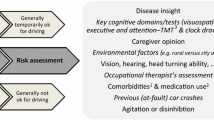Abstract
For people with epilepsy, ability to drive is the highest valued aspect of quality of life, and being denied a driving license is felt as stigmatizing. The explanation for this is better employment possibilities for those who are able to drive. In Germany a physician who treats a person with epilepsy must inform her/him if s/he does not fulfill the official criteria for driving, otherwise in case of an accident the physician may be held responsible (“physician liability”). There is lacking empirical evidence that information and possible negative sanctions may make patients who are not able to drive compliant with official driving regulations. In Germany persons who are not able to drive may obtain three types of assistance: a) transportation to the work place by taxi or a similar service, if they are not able to use public transportation or if the time when using public transportation is too long, b) transportation by taxi or a similar service, if they have to work at places which can only be reached by car, c) free use of public transportation if they have an identity card for the disabled and are evaluated as being restricted in their ability to move safely in the public. The physician should give support to make patients with epilepsy, who are not able to drive, eligible for these different types of assistance.
Zusammenfassung
Für Menschen mit Epilepsie hat die Fahrerlaubnis eine hohe Bedeutung, vor allem, weil sie die beruflichen Beschäftigungschancen erhöht. Der fehlende Führerschein wird von den Betroffenen aber auch als Zeichen für eine Stigmatisierung als Epilepsiekranker erlebt, nicht dagegen ein temporäres Fahrverbot bei Führerscheinbesitz. Der behandelnde Arzt muss seine Patienten über eine nicht gegebene Fahreignung informieren und in bestimmten Situationen, dann wenn die konkrete Gefahr eines Unfalls durch einen Anfall besteht, ihnen das Fahren verbieten, anderenfalls es zur „Arzthaftung“ kommen kann. Es ist bislang allerdings ungeklärt, inwieweit diese Maßnahmen und andere mögliche Sanktionen bei unerlaubtem Fahren, Patienten davon abbringen ein Fahrzeug zu führen. In Deutschland soll die „Kraftfahrzeughilfe“ behinderten, nicht fahrgeeigneten Personen ermöglichen ihren Arbeitsplatz zu erreichen, dann wenn sie nicht in der Lage sind öffentliche Verkehrsmittel zu benützen oder wenn öffentliche Verkehrsmittel nicht zur Verfügung stehen. Eine weitere Hilfe für nicht fahrgeeignete Personen ist die „Arbeitsassistenz“: Wenn sie Arbeiten ausführen müssen, bei denen sie nur mit einem Kfz den Einsatzort erreichen können, können ihnen durch das Integrationsamt oder einen Rehabilitationsträger die Kosten für einen Fahrer erstattet werden. Die unentgeltliche Beförderung mit öffentlichen Verkehrsmitteln (Voraussetzung: Merkzeichen G im Schwerbehindertenausweis) ist keine speziell für nicht fahrgeeignete Personen konzipierte Hilfe aber dennoch sehr nützlich für Patienten, die nicht Auto fahren dürfen. Nicht fahrgeeignete Patienten sollten deshalb dabei unterstützt werden, das Merkzeichen G zu erhalten.
Similar content being viewed by others
Literatur
Bauer J, Burchard G-D, Saher S (2006) Mobilität und Epilepsie. Steinkopff Darmstadt
Bautista RED, Wludyka P (2006) Driving prevalence and factors associated with driving among patients with epilepsy. Epilepsy & Behavior 9:625–631
Begutachtungs-Leitlinien zur Kraftfahrereignung (2000) Gemeinsamer Beirat für Verkehrsmedizin, Bundesanstalt für Straßenwesen, Referat Öffentlichkeitsarbeit, Bergisch Gladbach
Berg AT et al (2000) Driving in adults with refractory localization-related epilepsy. Neurology 54(3):625 ff
BMAS (1996) Anhaltspunkte für die ärztliche Gutachtertätigkeit im sozialen Entschädigungsrecht und nach dem Schwerbehindertengesetz. Bundesministerium für Arbeit und Sozialordnung, Referat Öffentlichkeitsarbeit, Bonn
Elger CE, Poersch M, Hefner G, Voss Th, Hufnagel A (o. J.) Führerschein und Epilepsie
Ernst K-F, Adlhoch U, Seel H (Hrsg) (2002) Sozialgesetzbuch IX Rehabilitation und Teilhabe behinderter Menschen – Kommentar (Loseblattausgabe), Kohlhammer, Stuttgart
Gilliam F et al (1997) Patient-validated Content of Epilepsy-Specific Quality-of-Life Measurement. Epilepsia 38(2):233–236
Jacoby A, Gamble C et al (2007) Quality of life outcome of immediate or delayed treatment of early epilepsy and single seizures. Neurology 68(15):1188–1196
Krauss G et al (1999) Risk factors for seizure-related motor vehicle crashes in patients with epilepsy. Neurology 52:1324–1329
Martin R et al (2005) What are the concerns of older adults living with epilepsy? Epilepsy & Behavior 7:297–300
McLachlan RS, Starreveld E, Lee MA (2007) Impact of mandatory physician reporting on accident risk in epilepsy. Epilepsia 48(8):1500–1505
Paul M (2007) Epilepsie und Stigmatisierung, Risikofaktoren bei Menschen mit Epilepsie. Universität Bielefeld, Fakultät für Psychologie und Sportwissenschaften, Bielefeld
Peitz J, Hoffmann-Born H (2005) Arzthaftung bei problematischer Fahreignung. Kirschbaum Verlag, Bonn
Polychronopoulos P et al (2006) Factors associated with poor compliance of patients with epilepsy driving restrictions. Neurology 12(67):869–871
Taylor DC et al (2001) Patients' aims for epilepsy surgery: desires beyond seizure freedom. Epilepsia 42(5):629–633
Taylor J, Chadwick D, Johnson T (1996) Risk of accidents in drivers with epilepsy. J Neurology, Neurosurgery and Psychiatry 60:621–627
Taylor JF (o. J.) Epilepsy and other causes of collapses at the wheel, in. The Royal Society of Medicine, Driving and Epilepsy – and other causes of impaired cociousness, o. J. International Congress and Symposium Series, Number 60:4–7
Thorbecke R, Loer B (2007) Postsurgical rehabilitation. In: Lüders H, Najm I, Bingaman W (eds) Textbook of Epilepsy Surgery, third edition, in preparation
Thorbecke R et al (2006) Perceived stigma in epilepsy: association with clinical, neuropsychological and psychosocial variables. In: AES/ACNS Joint Meeting, Washington DC, December 2.–6. 2006
Van der Lugt PJM (1975) Is an Application Form Useful To Select Patients with Epilepsy Who May Drive? Epilepsia 16:743–746
Wilson S et al (1998) Patient expectations of temporal lobe surgery. Epilepsia 39(2):167–174
Author information
Authors and Affiliations
Corresponding author
Rights and permissions
About this article
Cite this article
Thorbecke, R. Beratung und sozialrechtliche Hilfen für (noch nicht) fahrgeeignete Epilepsiepatienten. Z. Epileptol. 20, 176–183 (2007). https://doi.org/10.1007/s10309-007-0274-9
Received:
Accepted:
Issue Date:
DOI: https://doi.org/10.1007/s10309-007-0274-9




